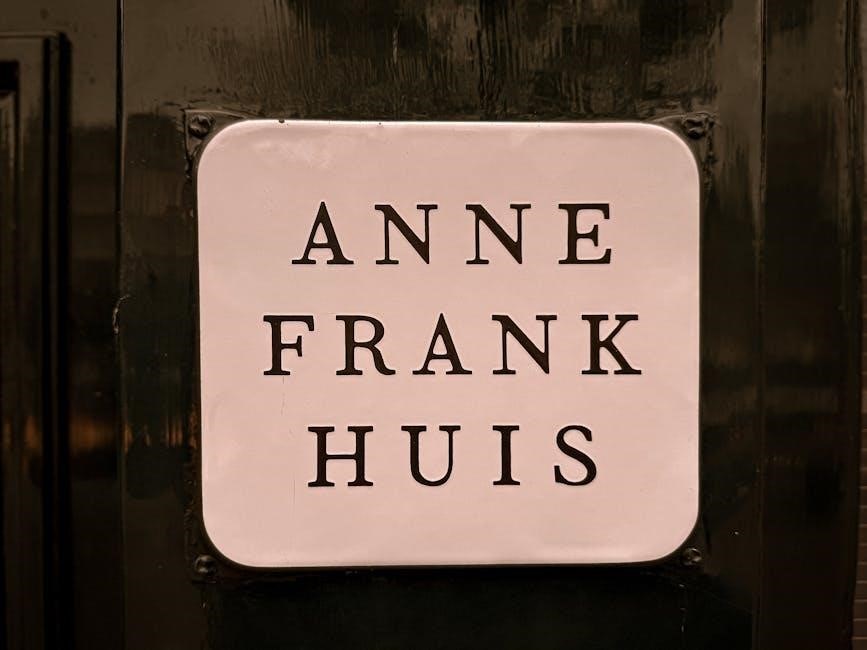The Diary of Anne Frank: An Overview
The Diary of Anne Frank‚ written between 1942 and 1944‚ is a poignant account of a young girl’s life in hiding during WWII. It captures her hopes‚ fears‚ and reflections‚ offering a deeply personal perspective on one of history’s darkest periods. The diary‚ inspired by Gerrit Bolkestein’s speech‚ was later edited and published by her father‚ Otto Frank‚ becoming a powerful testament to the human spirit and a crucial historical document.
When Did Anne Frank Start Writing Her Diary?
Anne Frank began writing her diary on June 12‚ 1942‚ when she received it as a gift for her 13th birthday. Initially‚ she used it as a private space to express her thoughts and feelings‚ documenting her daily life in Amsterdam. The diary quickly became her confidant‚ where she shared her hopes‚ fears‚ and reflections. Over time‚ Anne’s entries evolved‚ revealing her growing awareness of the world around her and her desire to become a writer. By 1944‚ inspired by a speech by Gerrit Bolkestein‚ she started rewriting parts of her diary with the intention of publishing it after the war. This marked a significant shift in her approach‚ as she refined her writing and structured it for a broader audience. The diary became not only a personal journal but also a testament to her aspirations and the historical events unfolding around her.
The Time Period Covered in the Diary
Anne Frank’s diary spans from June 12‚ 1942‚ to August 1‚ 1944‚ documenting her life during the Nazi occupation of the Netherlands. The entries begin with her 13th birthday‚ detailing her initial excitement about the diary and her everyday life in Amsterdam. As the war intensifies‚ Anne and her family go into hiding in the Secret Annex‚ and the diary becomes a chronicle of their life in confinement. The entries reveal the challenges of living in close quarters‚ the fear of discovery‚ and the emotional struggles of adolescence. The diary ends abruptly in August 1944‚ when the Nazi authorities discover the Secret Annex‚ leading to the arrest and deportation of Anne and her family. This period captures the innocence of youth juxtaposed with the harsh realities of war‚ offering a unique and poignant perspective on one of history’s most tragic events.
Who Inspired Anne Frank to Consider Publishing Her Diary?
Anne Frank’s decision to consider publishing her diary was inspired by a speech by Gerrit Bolkestein‚ a Dutch government official in exile‚ broadcast on Radio Orange in March 1944. Bolkestein called for collecting diaries‚ letters‚ and documents to document the experiences of the Dutch people during the Nazi occupation. This speech deeply moved Anne‚ who realized her diary could serve as a powerful record of life under persecution. She began rewriting and editing her diary with the goal of publishing it after the war‚ envisioning it as a book that would reveal the truth about the suffering of Jews during the Holocaust. This inspiration marked a turning point‚ as Anne saw her diary not just as a personal confidant but as a potential tool for sharing her story with the world.

Historical Context of the Diary
Gerrit Bolkestein‚ a Dutch government official‚ inspired Anne Frank to consider publishing her diary. In a 1944 radio speech‚ Bolkestein urged the preservation of diaries and letters to document the Dutch experience under Nazi occupation. This speech motivated Anne to revise her diary with the goal of publication‚ envisioning it as a testament to the suffering of Jews during WWII. She began editing her entries‚ transforming her personal reflections into a structured narrative. Bolkestein’s call to action gave Anne a new purpose‚ shifting her diary from a private confidant to a potential historical record. This inspiration was pivotal‚ as it led to the diary’s eventual publication by her father‚ Otto Frank‚ after the war‚ ensuring her story reached the world.

The Holocaust and World War II: The Setting of the Diary
Anne Frank’s diary is set against the backdrop of the Holocaust and World War II‚ a period marked by unprecedented atrocities. The diary spans from June 1942 to August 1944‚ documenting Anne’s life in hiding with her family in Amsterdam to evade Nazi persecution. The Holocaust‚ a systematic genocide of six million Jews‚ created an atmosphere of fear and uncertainty. Anne’s diary vividly captures the daily struggles‚ hopes‚ and fears of those in hiding‚ offering a personal lens through which to view this dark chapter of history. The diary also reflects the broader context of WWII‚ including the Nazi occupation of the Netherlands and the constant threat of discovery. Through her writings‚ Anne humanizes the statistics of the Holocaust‚ providing an intimate and powerful account of survival‚ resilience‚ and the loss of innocence. Her story remains a poignant reminder of the human cost of war and prejudice.

The Secret Annex in Amsterdam: Where the Diary Was Written
The Secret Annex‚ located above Anne’s father’s office building in Amsterdam‚ was the hiding place where Anne Frank wrote her diary. This concealed space‚ shared with seven others‚ was their refuge from Nazi persecution. The annex‚ though cramped and claustrophobic‚ became a sanctuary where Anne expressed her deepest thoughts. The diary vividly describes life within these walls‚ detailing daily routines‚ tensions‚ and the struggle to maintain hope amidst confinement. Anne’s writings reflect the annex’s role as both a physical and emotional shelter‚ where she found solace in her diary. The Secret Annex remains a symbol of resilience and the human spirit’s ability to endure even in the most oppressive conditions‚ immortalized through Anne’s words.
The Significance of the Diary During the Holocaust
Anne Frank’s diary is a profound and deeply personal account of life during the Holocaust‚ offering an intimate perspective on one of history’s darkest chapters. Written in the Secret Annex‚ the diary captures the daily struggles‚ hopes‚ and fears of those in hiding‚ providing a humanizing glimpse into the lives of Holocaust victims. It transcends mere documentation‚ becoming a testament to the resilience of the human spirit. The diary’s emotional depth and vivid storytelling make it a powerful tool for educating future generations about the Holocaust‚ fostering empathy and understanding. Its significance lies not only in its historical value but also in its ability to connect readers with the personal experiences of those who endured unimaginable suffering. As a memorial to Anne and the millions who perished‚ the diary serves as a poignant reminder of the importance of tolerance and peace.

The Publication Journey of the Diary
Otto Frank led the publication journey of Anne’s diary‚ ensuring its powerful message reached the world. After the war‚ he dedicated himself to editing and preparing the diary for release‚ preserving its emotional depth and historical significance. The Definitive Edition‚ including previously unpublished material‚ further highlighted Anne’s profound insights and legacy‚ making her diary a timeless testament to hope and resilience.
Otto Frank’s Role in Publishing the Diary After the War
Otto Frank‚ Anne’s father and the only survivor of the group in hiding‚ played a pivotal role in publishing her diary. After the war‚ he returned to Amsterdam and discovered that Miep Gies‚ one of the people who had helped them while in hiding‚ had preserved Anne’s diary. Recognizing the historical and emotional significance of the diary‚ Otto dedicated himself to editing and preparing it for publication; He faced the challenge of condensing the diary while maintaining its authenticity and impact. Otto’s efforts led to the diary’s first publication in 1947‚ under the title The Diary of a Young Girl. His dedication ensured that Anne’s story reached a global audience‚ preserving her legacy and providing a powerful testament to the experiences of those persecuted during the Holocaust. Otto’s role was instrumental in making the diary one of the most important books of the 20th century.

The Process of Editing and Preparing the Diary for Publication
Preparing Anne Frank’s diary for publication involved a meticulous editing process to ensure its authenticity and accessibility. Otto Frank‚ with the assistance of historians and editors‚ carefully reviewed the diary entries‚ selecting and condensing the content while preserving Anne’s voice and emotional depth. The original diary contained multiple drafts and reflections‚ which were organized into a cohesive narrative. Some passages were omitted to protect the privacy of individuals mentioned or to focus on the most significant events. The editors also ensured the diary was suitable for a broader audience‚ maintaining its historical integrity while making it relatable. This process highlighted Anne’s literary talent and the universal themes of her writings. The final edition‚ first published in 1947‚ became a powerful historical document‚ offering insights into life during the Holocaust and the resilience of the human spirit.
The Impact of the Definitive Edition of the Diary
The Definitive Edition of Anne Frank’s diary‚ published with previously unpublished material‚ has profoundly impacted readers worldwide. This comprehensive version offers deeper insights into Anne’s thoughts‚ feelings‚ and experiences‚ providing a more complete understanding of her life in hiding. It has allowed readers to connect more deeply with her humanity and the historical context of the Holocaust. The inclusion of additional passages has also sparked new discussions about the diary’s significance and its relevance to contemporary issues. Educators and scholars have embraced this edition for its authenticity and breadth‚ making it a vital resource for teaching about WWII and the Holocaust. The Definitive Edition has ensured that Anne’s story continues to resonate with new generations‚ fostering empathy and understanding of one of history’s darkest periods.
